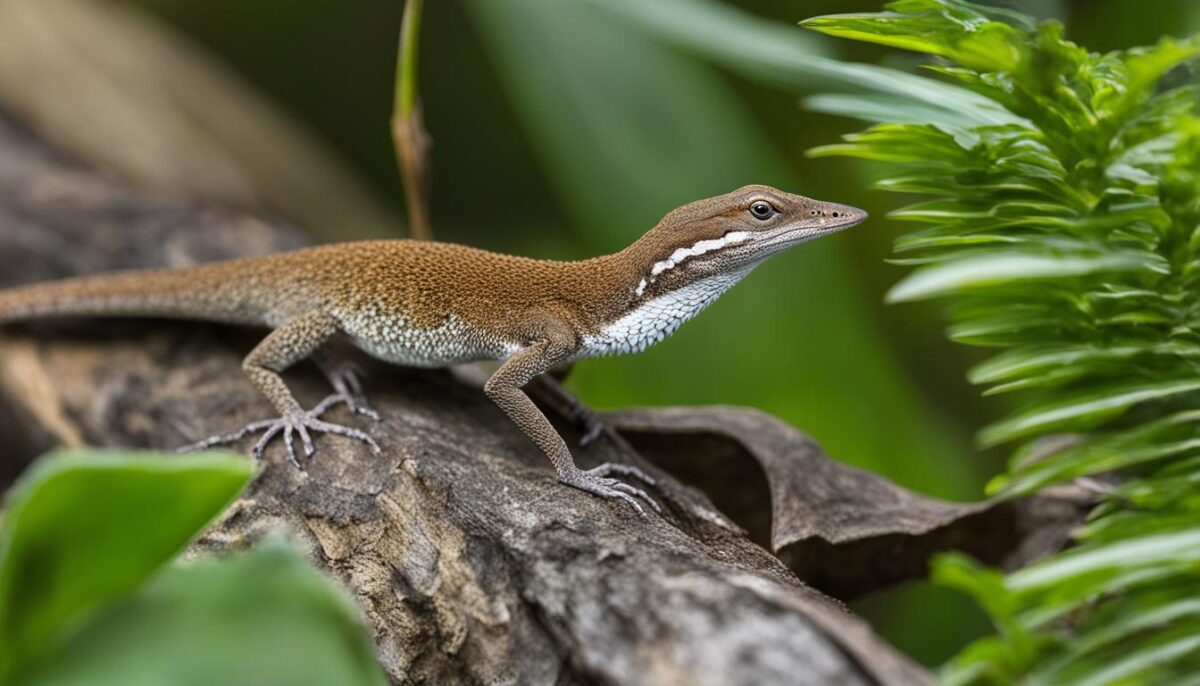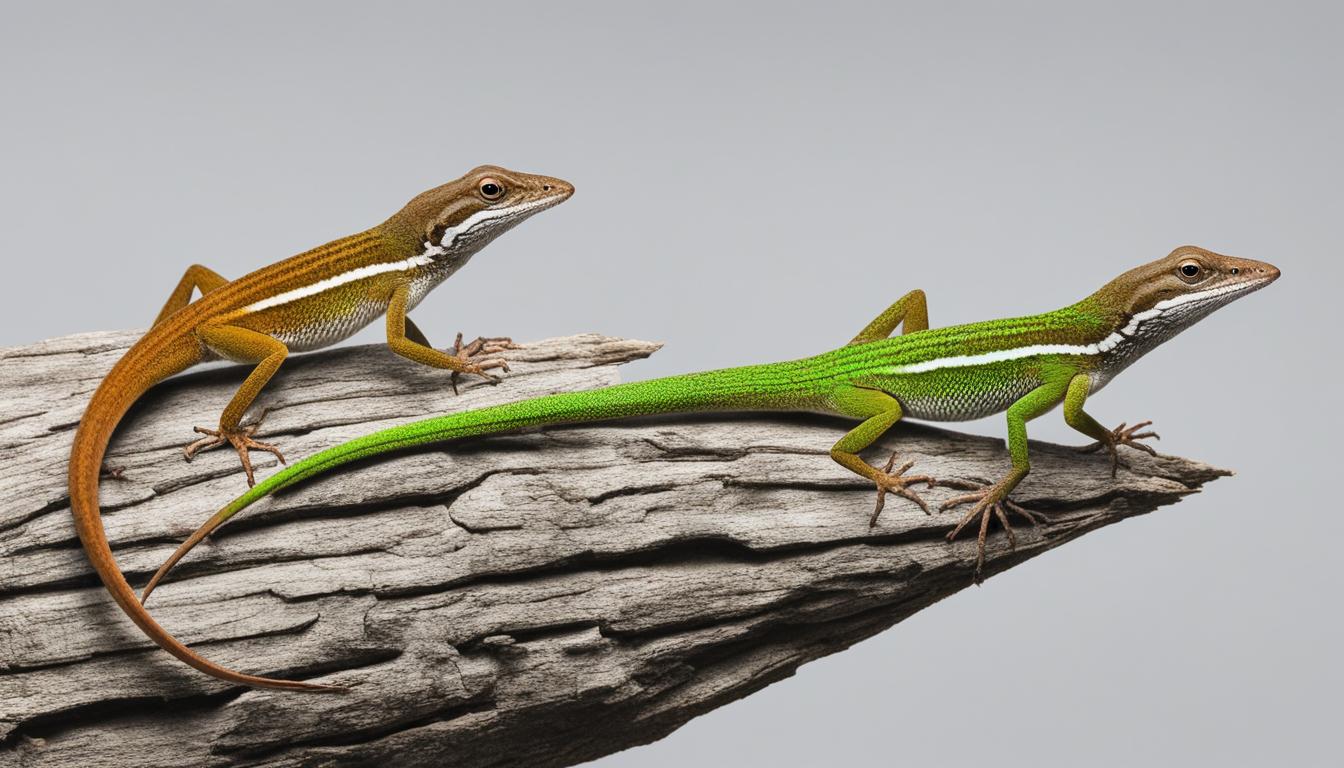Brown anoles, native to North America, are fascinating creatures with distinct differences between males and females. By observing their characteristics, patterns, and behavior, it’s possible to easily determine the gender of these reptiles. Let’s explore the key factors that differentiate male and female brown anoles in more detail.
Key Takeaways:
- Brown anoles are sexually dimorphic, meaning it’s possible to tell the gender by visual cues.
- Males are larger, measuring around 2 inches, while females are smaller, measuring closer to 1 1/2 inches.
- Females have a white dorsal stripe and a dark triangular pattern, distinguishing them from males.
- Males have a large dewlap, which is bright orange-red in color and used for mating displays and territorial defense.
- Understanding these differences helps in identifying and appreciating the unique characteristics of male and female brown anoles.
Size and Weight Differences
When it comes to the size and weight of brown anoles, there are distinct differences between males and females. Males tend to be larger in size, measuring approximately 2 inches in length, while females are smaller, measuring around 1 1/2 inches.
Let’s take a closer look at the weight aspect. Male brown anoles can weigh up to 1/3 of an ounce, showcasing their larger structure. On the other hand, females weigh roughly 1/6 ounce, reflecting their smaller size and lightweight composition.
This variation in size and weight is an important factor in distinguishing between male and female brown anoles. These differences can be observed and provide valuable insights into the gender identification of these fascinating creatures.
| Characteristics | Male Brown Anole | Female Brown Anole |
|---|---|---|
| Size (Length) | Approximately 2 inches | Around 1 1/2 inches |
| Weight | Up to 1/3 ounce | Roughly 1/6 ounce |
Males, with their larger size and weight, stand out in comparison to their female counterparts. These differences play a crucial role in discerning the gender of brown anoles and understanding their overall biology and behavior.

| Male Brown Anole | Female Brown Anole | |
|---|---|---|
| Reproductive Role | Play a significant role in the reproductive process. | Play a significant role in the reproductive process. |
| Mating Encounter Duration | Lasts only 1-2 minutes. | Lasts only 1-2 minutes. |
| Copulation Duration | Lasts between 30 and 60 minutes. | Lasts between 30 and 60 minutes. |
| Egg Laying | – | Lays one or two eggs in a suitable spot. |
| Breeding Season Duration | Shorter breeding season compared to females. | Longer breeding season compared to males. |
Habitat and Geographic Distribution
Brown anoles are highly adaptable reptiles that can thrive in a diverse range of habitats. They are commonly found in:
- Dense forests
- Areas with open vegetation
- Moist environments
These cunning creatures have a wide geographic distribution. They are native to North America, specifically from Florida to southern Mexico, and can also be found in Cuba, the Bahamas, and other parts of the Caribbean.
Unfortunately, brown anoles have become an invasive species in certain regions. They have been introduced to several states, including Georgia, Louisiana, Texas, California, and Hawaii.
Despite their invasive status, brown anoles have managed to adapt and thrive in their new environments.
| Habitat | Geographic Distribution |
|---|---|
| Dense forests | North America, Cuba, the Bahamas, and the Caribbean |
| Areas with open vegetation | North America, Cuba, the Bahamas, and the Caribbean |
| Moist environments | North America, Cuba, the Bahamas, and the Caribbean |
| Invasive regions | California, Georgia, Hawaii, Louisiana, Texas |
Conclusion
Distinguishing between male and female brown anoles can be done by observing their size, color, pattern, dewlap, and behavior. Males are generally larger than females and possess a colorful dewlap, while females exhibit distinct patterns and have a smaller dewlap. These characteristics make it easier to identify and differentiate between male and female brown anoles.
Understanding the differences between male and female brown anoles provides valuable insights into their fascinating world. These distinctions enable researchers and enthusiasts to study and monitor the population dynamics, behavior, and reproductive patterns of these unique creatures. By analyzing their characteristics, we can gain a deeper understanding of their roles and contributions within the ecosystem.
As researchers continue to explore this species, it is essential to recognize the significance of these male and female characteristics and their impact on overall brown anole biology. By preserving their natural habitats and promoting the conservation of these distinctive reptiles, we can ensure their continued existence and the preservation of their ecological role in their respective environments.
FAQ
What are the differences between male and female brown anoles?
Male brown anoles are larger in size and have a colorful dewlap, while females are smaller and exhibit distinct patterns on their bodies.
How can I tell the gender of a brown anole?
You can identify the gender of a brown anole by observing their size, coloration, patterns, and the presence or absence of a dewlap.
Are there differences in size and weight between male and female brown anoles?
Yes, male brown anoles are larger, measuring approximately 2 inches in length and weighing up to 1/3 of an ounce, while females are smaller, measuring around 1 1/2 inches and weighing roughly 1/6 ounce.
Do male and female brown anoles have different colors and patterns?
Yes, brown anoles of both genders can vary in color from light gray to black, but females always have a white dorsal stripe and a dark triangular pattern, which males lack.
What is the difference in dewlap between male and female brown anoles?
Male brown anoles have a larger dewlap, which can be extended to reveal a bright orange-red color. Females have a smaller dewlap that is rarely extended.
How do male and female brown anoles behave?
Males are more aggressive and territorial, especially during mating displays and defending their territory from other males. Females exhibit less territorial behavior and are known to store sperm and continue fertilizing eggs even after the male breeding season has ended.
Where are brown anoles found and what is their geographic distribution?
Brown anoles are native to North America, specifically from Florida to southern Mexico, as well as Cuba, the Bahamas, and other parts of the Caribbean. They have also been introduced as an invasive species in several states, including Georgia, Louisiana, Texas, California, and Hawaii.
What are the main distinctions between male and female brown anoles?
The main differences between male and female brown anoles are their size, coloration, patterns, dewlap appearance, and behavior. These characteristics can be used to identify the gender of brown anoles.


